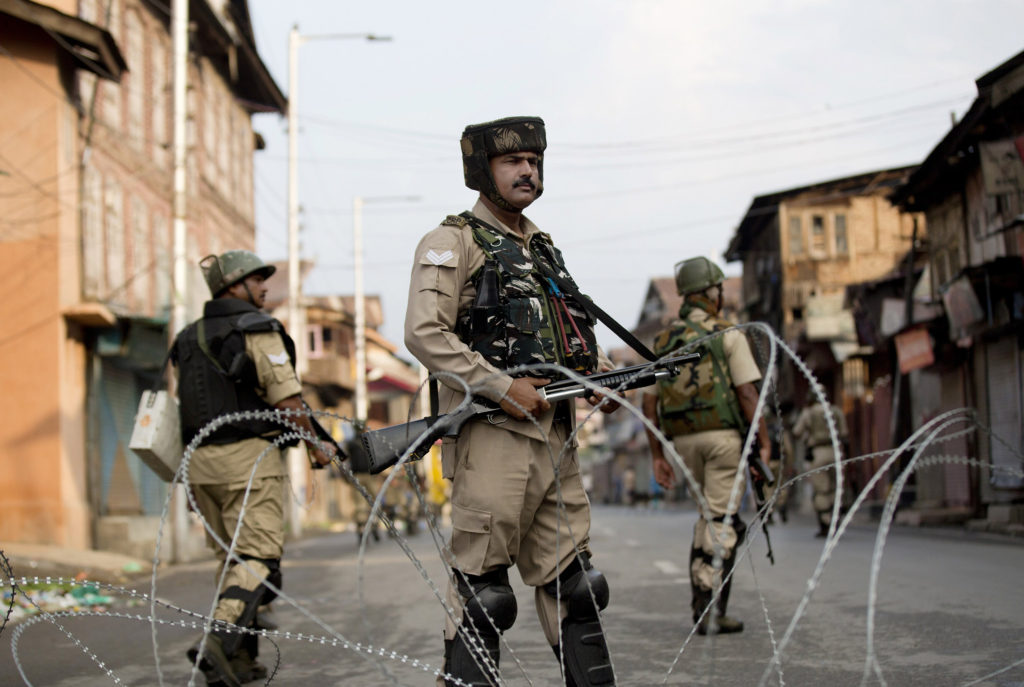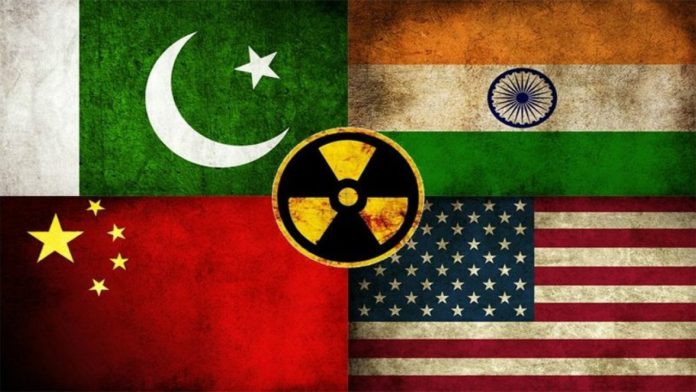The South Asian region has completed twenty-four years of its nuclear deterrence without having substantial progress in defusing tensions between India and Pakistan. The completion of more than two decades of nuclearization in South Asia has restrained both New Delhi and Islamabad from being involved in a direct war without minimizing their historical points of disagreement. Indian quest to ensure a regional hegemonic status in South Asia and Pakistan’s ambitions for keeping its home region away from New Delhi’s offensive regional policies remained the fundamental reasons for South Asian nuclearization, which created a deterrence between India and Pakistan. In 1998, both governments’ decision for acquiring nuclear weapons status was the prime factor that introduced the constructive role of deterrence in South Asia and prevented threats of a direct war between two nuclear rivals. The establishment of deterrence between India and Pakistan added another chapter in the history of South Asia and turned the New Delhi-Islamabad historical rivalry more hostile and less stable. The element of stability posed a serious question on the role of deterrence in the region due to the persistent evolution of India-Pakistan rivalry under their toxic diplomatic interaction. In this way, the constantly multiplying mainstream points of disagreement between the two nuclear states undermined the role of nuclear deterrence in the region. The Indian quest for playing a dominating role in its home region and Pakistan’s mission for counterbalancing Indian regional hegemonic ambition proved to be the prime factors that diminished the role of nuclear deterrence in South Asia. The continuation of Indian and Pakistani inflexible standing in the nuclearized subcontinent has resulted in various contrasting strategic differences that undermined the deterring role of their nuclear weapon capabilities. Even on the completion of twenty-four years of nuclear deterrence in 2022, it is not easy to maintain a satisfactory position on the presence of nuclear deterrence between India and Pakistan. The unprecedented growth of strategic contest between both nuclear-weapon states has remained the primary reason for leaving negative impacts on the deterring role of nuclear weapons, which could be measured on the following lines.
1. The India-Pakistan hostility motivates leaders of both nations, under different political administrations, to remain strict with their strategic inflexibilities. The Indian mission for establishing a regional hegemonic status has convinced New Delhi to craft various offensive initiatives against other regional states where Pakistan comes first. Indian aggression against Pakistan has introduced a nuclear arms race in South Asia and pushed the whole region towards nuclearization. Pakistan’s timely response to Indian nuclear weapon tests in 1998 raised New Delhi’s worries about Islamabad’s determination to oppose Indian regional dominating plans. Additionally, the rising levels of New Delhi’s anti-Pakistani behaviour has continually developed different designs of New Delhi’s Pakistan-specific offensive measures, which is a direct threat to the regional strategic matrix in South Asia. The episode of the Balakot strike validates this argument when the Modi government decided to violate the territorial sovereignty of Pakistan in 2019. This was an Indian effort to place Pakistan at a disadvantageous position in the regional strategic competition by conducting an aerial strike against Pakistan. But the timely response of the Pakistan Air Force and the release of the captured Indian pilot were careful moves by Islamabad that de-escalated the tension and sent a message of peace to New Delhi. It was a short episode of the India-Pakistan rivalry. However, it raised questions on the efficacy of nuclear deterrence in South Asia while highlighting the probability of repetition of such incidents.
2. The quest for maintaining a regional hegemonic status convinced New Delhi on the acquisition of multileveled strategic capabilities in the territorial and maritime affairs of South Asia. The pursuit of polishing its strategic muscles over territorial and maritime affairs resulted in New Delhi’s policy of massive weaponization, which is constantly introducing various weapons trends in the region under the nuclear shadows. Launching of the nuclear-capable submarine in the surrounding waters has increased Indian nuclear triad capabilities. The completion of the nuclear triad encouraged New Delhi toward the acquisition of space capabilities which launched a space race in the South Asian regional nuclear order. Moreover, New Delhi’s plans for modernizing its existing defensive mechanism with the help of artificial intelligence technology have further become another essential feature of the South Asian arms race. Apart from these developments, New Delhi’s strategic thinkers are continuously engaged in diversifying the existing Indian weapons systems. These strategic developments in the presence of nuclear weapons have proved to be the main forces undermining the presence of nuclear deterrence between India and Pakistan.

3. Indian strategic planners have always preferred to align New Delhi with different states from across the globe while developing strategic connections with technologically advanced and scientifically developed nations. The formulation of strategic ties with the developed nations has allowed New Delhi to connect its indigenous weapon industry with leading Military-Industrial Complexes of the world. Furthermore, New Delhi’s increasing collaborative ties with the great powers is another critical point hampering the role of nuclear deterrence in South Asia. The improving strategic ties with the great powers have only increased extra-regional powers in South Asia, which has complicated the regional strategic matrix between two nuclear powers. The increasing levels of Indian strategic bilateralism with the great powers have resulted in a brief series of civil nuclear deals, different security pacts, and various defence agreements between India and several other nations. Thus, the growing influence of great powers in the nuclearized subcontinent and the increasing number of Indian strategic connections with various nations have negative impacts on South Asian nuclear deterrence.
4. The Indian anti-Pakistan behaviour is a permanent feature of the South Asian regional security environment, which could be considered the fundamental reason for the New Delhi-Islamabad strategic competition. The decades-long India-Pakistan rivalry is mainly rooted in New Delhi’s multileveled antipathy towards Islamabad and its permanent opposition to the role of Pakistan’s Islamic ideology in the South Asian region. Furthermore, the ideological support of Pakistan to the Muslim communities suffering from hostile Indian behaviour in Kashmir and inside India has been translated as the main threat to Indian fanatical Hindu ideologies. The arrival of Modi in Indian politics has augmented the traditional patterns of Indian anti-Pakistan thinking, which have multiplied the mainstream points of disagreements between New Delhi and Islamabad. During the Balakot Crisis, the aggression of the Modi government under the fanatical ideological patterns of Hindutva has brought the South Asian region to the brink of nuclear war. Thus, Modi’s version of Hindutva has started jeopardizing the scope of nuclear deterrence in South Asia. In contrast to Pakistan’s efforts to stabilise the regional deterrence, Indian leadership under the Modi government is directly fracturing the regional strategic matrix between India and Pakistan.
Based on the above, it can easily be maintained that the history of South Asian nuclear deterrence has remained disturbed under the Indian offensive strategic thinking. The Indian government strictly emphasizes on the accomplishment of its regional strategic aspiration to curb Pakistan’s counterbalancing efforts, which have failed to minimize Islamabad’s role in South Asia. Despite facing Indian anti-Pakistan diplomacy in regional and extra-regional affairs, Pakistan’s government is determined to cultivate a multidimensional strong diplomatic connection with the international community. Presently, the Modi government has launched various patterns of hybrid warfare in which the promotion of Pakistan-specific disinformation campaigns has become the latest offensive of New Delhi against Pakistan. While keeping in view the scenario mentioned above, the greater responsibility lies on the shoulders of the international community, which is busy actively establishing its strategic connections with New Delhi. Therefore, the productive role of the international community could play a positive role in stabilizing the regional strategic matrix between two nuclear powers which share borders. The government of Pakistan has several times referred to the active role of extra-regional forces in stabilizing the regional nuclear deterrence, instead of pursuing their strategic objective with the help of New Delhi.




